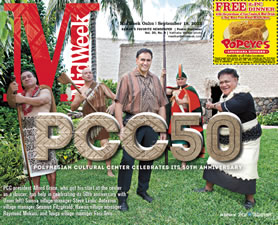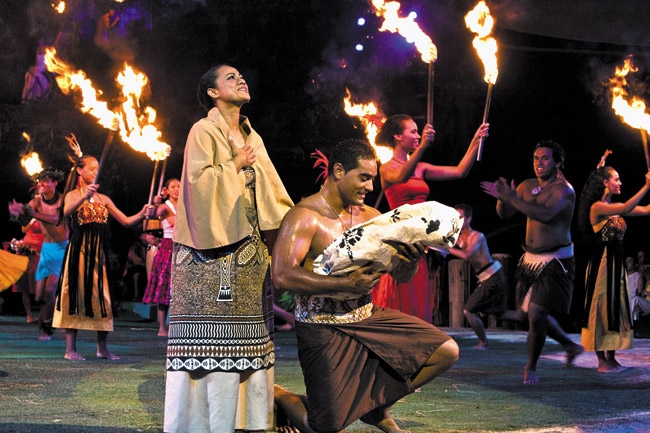PCC 50
POLYNESIAN CULTURAL CENTER CELEBRATES ITS 50TH ANNIVERSARY
Help wanted. Laie, Oahu. Must climb trees, husk coconuts, dance the Samoan slap or Tahitian otea, toss Fijian spears, swing poi balls, hula on a moving canoe, fish with kids in a lagoon, play the ukulele and twirl flaming fire knives. All while attending school. Unlimited opportunity for qualified candidates. Apply at Polynesian Cultural Center (PCC).
mw-cover-091813-pcc-8
Sound like a fun job? To date, more than 18,000 Brigham Young University-Hawaii (BYUH) students from 70 countries have answered the casting call while earning their way through college.
The result is the making of Hawaii’s top attraction that hosts 700,000 visitors a year. PCC is thriving in its 50th year of a unique mission in educational tourism or edutourism.
When PCC started in 1963, skeptics laughed and predicted it would be a flop. Who would venture so far from Waikiki to watch amateurs perform?
Who indeed?
Only 37 million visitors to date. The flop is a phenomenon.
Today one finds the North Shore’s anchor attraction in a state of Grace. Alfred Grace, that is, the center’s new president and chief executive officer.
He greets us on a Friday morning at his office on the BYUH campus in Laie. He arrives after taking a spin on his motor scooter from one appointment to another. When one administers a 42-acre operation, rapid transit is a must.
But it could be said that Grace has “arrived” in more ways than one.
His journey at BYUH began in 1983 when he enrolled as a freshman on a rugby scholarship from the remote village of Turangi, New Zealand. Typical of most BYUH students, he worked part time at PCC to pay for his education and living expenses.
“I was able to work my way through school and graduate without college debt,” he says. “It was a blessing and a wonderful experience. At first, I had a difficult time speaking before people and interacting with guests. But it is a very comfortable environment in which one shares one’s own cultural background.”
Grace worked as a dancer, trolley driver, tour guide, stage technician, reservationist, sales and marketing executive, and chief operating officer. In 2012, he was named to succeed Von Orgill as president-CEO.
He is the first person to work through the ranks of PCC to ascend to its highest executive post and only the second person of Polynesian ancestry to hold this office.
As such, Grace could be the poster boy for PCC’s purpose and mission.
PCC was established in 1963 to contribute to the educational development and growth of BYUH students and residents in Laie. Both BYUH and PCC are owned and operated by the Church of Jesus Christ of Latter-day Saints.
Commenting on Grace’s appointment, PCC director of cultural presentations Delsa Moe, a Samoan, says, “Growing leaders is what this place is about. To me, it’s irrelevant that he’s Polynesian. That’s a nice touch, but it’s more important that he was trained and groomed here.”
With his good-natured Kiwi humor, Grace suggests, “Well, if you work here long enough, you’ll either be replaced or promoted.”
The golden anniversary of PCC was highlighted by the return of 3,000 alumni this month for a festive reunion. Coming from South Pacific islands and Utah, where many graduates reside, they gathered Sept. 1-8 in Laie for a series of historical presentations, receptions, concerts and alumni evening shows.
Many have gone on to successful careers in their communities. One such graduate is Bode Uale, who is the first family court judge appointed in the U.S. of Samoan descent. Uale serves as the lead judge in the Honolulu Family Court’s Domestic Division.
Uale wrote on the PCC alumni blog:
“I knew that PCC was special because my grandparents, James Amilale and Elisa (Crichton) Uale, helped to build it.
“Years later, after my dad, Jack Uale, retired from the U.S. Army in 1974, we returned to Laie. Dad worked for Vern Hardisty in the villages and later managed the old dining lanai. Then he worked as the theater manager and supervised the promo team before he retired from PCC.
“I worked as a tram driver and danced in the night show before my mission, and at Laie Tours when I returned home. I also worked as the sales guide supervisor at the front gate before transferring to the Waikiki ticket office, where I worked nights during and after attending law school at UH.
“I’m grateful for the many work experiences I had at PCC, which prepared me to work as a lawyer and ultimately as a family court judge.”
His wife, Beth Parker Uale, grew up in Southern California before attending BYUH and worked at PCC, where she met her future husband. They now live in Hawaii Kai. She recalls:
“In 1976 I started school at BYU-Hawaii and was hired to work at the tohua (Marquesas). During my time at PCC, I was the leader for the Marquesan canoe, the Alii canoe and was the first narrator for the matinee show under PCC president Ralph Rodgers.
“My favorite experience was working in the matinee show since I was allowed to jump into the Maori section, the Hawaiian section, sing in the Samoan choir, play in the Brass Band, and occasionally act as a substitute for the English or American narrator. Although my employment at PCC lasted only four years, I learned so much about the Hawaiian, Marquesan, Maori and Samoan cultures.”
PCC, a nonprofit entity, is the only cultural theme park devoted solely to Polynesian arts, crafts, and traditions. Featuring six villages – Aotearoa (New Zealand), Fiji, Hawaii, Samoa, Tahiti, Tonga, and two exhibit areas – Marquesas and Rapa Nui – it is our Epcot Center of the Pacific.
The center is in the midst of a $100-million renewal that culminates in late 2014. If it’s been a while since you’ve visited PCC, it’s worth a return to view these new attractions and improvements:
* Redesigned Hawaii village reflective of an ahupua’a with new activities, architecture and exhibits.
* Hawaiian Journey: A 14-minute cinematic presentation in an IMAX theater with amazing special effects including water spray from the ocean.
* Addition of a second luau focused on the music, song, dance and culture of Samoa.
* Beautifully renovated 24,400-square-foot Gateway restaurant featuring two upgraded buffets given a menu makeover and farm-to-table fresh fare by executive chef Hector Morales, a nationally recognized James Beard-caliber chef.
* Expanded market place and variety of shops that will be enhanced by a 20,000-square-foot non-admission area to open late 2014 that will have shops, full-service restaurant and entertainment.
“We are preparing for the next 50 years,” Grace says. “We are sharing our mana’o (wisdom) so the next generation of leaders can carry on the mission. It is important for our future and the preservation of our lifestyle.
“We are delighted to be part of a tourism industry that works together for a common good,” he says while reflecting on the family of employees that make up PCC.
“In some cases, multiple generations of family members work here,” he points out. “My mother-in-law (Millie Enos) still dances in the night show and so does my wife (Valerie). My daughters (Weathirly, Summer and Phoebe) have danced here, too.”
He laughs, “I had to dance – it’s the only way I could attract my wife.”
These days, Grace dances with financial statements, blueprints for expansion, strategic plans and Laie public policy. But his mind and eyes are never off the guest experience at PCC.
“We want to be excellent in our core experiences, things that we are known for, such as the villages, canoe pageant, luau, movie presentation and night show. Ours is an interactive destination where people of diverse backgrounds find common ground.”
Human encounters in the resplendent tropical environment of PCC produce a magical product – cultural connectivity.
It also serves to remind kamaaina of their Pacific roots and traditions. While mindful of the time-and-distance boon-doggle that can be a barrier to the highly segmented kamaaina market, PCC continues to reinvent and refresh its offerings to appeal to local residents who comprise 20 percent of its market.
Events such as the annual world fire knife championships and $3 million stage production of Ha, Breath of Life with its 100-member cast make PCC a Disney-like magnet for families and groups.
The only thing it lacks is alcoholic beverages and Sunday hours. That’s not likely to change.
It’s a minor detail when the Polynesian Cultural Center is viewed in its most relevant context. Hawaii has an asset in an edutourism entity that reflects what world leaders call the Pacific Century. Mirroring the people, culture and promise of the island nations within the Polynesian triangle, of which Hawaii is a central player, it is PCC that teaches us to sing in perfect harmony.
For information on 50th anniversary specials and promotions, visit the PCC website at polynesia.com.







